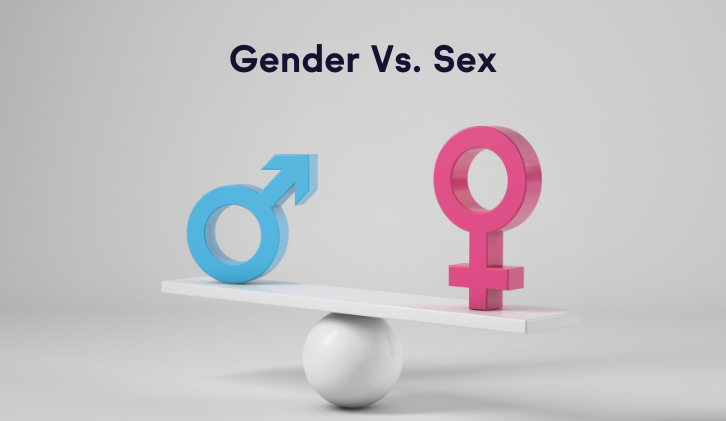Gender & Sex
Sex refers to biological characteristics, while gender is a social construct. Understanding these differences promotes inclusivity and supports transgender and non-binary individuals. Laura Wyglendacz, Staff Engineer at Liberis dives into the subject to clarify things.
Return to blog posts
As part of Liberis’ celebration of Pride month, the DE&I council decided to write about the difference between gender and sex. For many folk who identify as LGBTQIA+, particularly the trans community, the distinction is important. Sex and gender are sometimes used interchangeably, but they have different meanings.
Understanding the terms is a way of showing support for LGBTQIA+ colleagues. It can also help to challenge biased or problematic assumptions about individuals based on their perceived gender or sex.
Here is an infographic that visually describes the differences between the terms sex; gender identity; gender expression (outward presentation), and sexual/emotional attraction.

Sex
Sex is the term used to describe a set of biological attributes in humans, and in other animals. The sex categories are:
- male
- female
- intersex
When babies are born, doctors look at their genitalia and assign sex as male or female. In a small proportion of cases babies are identified as intersex, but often this is not apparent until later in life.
Genitalia are only one biological marker of sex. They are used due to their strong correlation with other sex attributes. Other sex attributes include hormones, internal sexual anatomy, gene expression and so on.
Gender
Sex as a concept applies to all animals. Gender is a human concept. It describes the set of rules, behaviours and expectations that have become associated with girls and women, boys and men in human society. Gender categories are:
- girls/women
- boys/men
- people who don’t conform to one of these may use terms to describe themselves like non-binary, a-gender, genderfluid.
Gender describes how we think about ourselves, how we express and present ourselves, and how we perceive and consider others. It is not always fixed and can change over time for some people.
Normalisation of understanding that gender is a social construct challenges the idea that ‘normal’ is a binary fixed category, and represents normality as a range of combinations of sex, gender identity, gender presentation, and attraction.
Why is the distinction important?
Societal ‘norms’ have typically associated gender closely to sex and seen it as a fixed thing. For example, Female-sexed babies are expected to grow into girls and women who behave in typically ‘feminine’ ways.
Girls falling outside of behavioural norms by choosing to dress or behave like typical boys of the same age are sometimes called ‘tomboys’. The category puts these girls ‘outside the norm’ and often comes with negative connotations. This is an example of gender morning.
Male-sexed babies are typically expected to grow into boys and then men who dress and behave in ways considered typical for their sex.
‘Boys will be boys’, is a common phrase used to normalise boisterous behaviour in male-sexed children – another example of gender norming in action.
These social expectations link biology (sex) closely with behaviour – resulting in the traditional idea that there are normally two fixed options for sex/gender pairing in humans:
- To be biologically male and to identify as, behave and look like a boy/man
- To be biologically female and to identify as, behave and look like a girl/woman
The ‘normal’ expectation that humans fall into one of two categories can be harmful. Societal rules are complex and slow to change, with power and majority being strong influences on what is considered ‘normal’.
Those outside the ‘norm’ are regularly excluded and marginalised for being different. They may act differently to what feels natural to them in order to stay safe and fit in, which is tiring and harmful in of itself.
By understanding the difference between biological sex and societal gender, it is possible to acknowledge that many people do not fit the two binary sex/gender norms described above.
Transgender
Transgender is the term used to describe people who consider their gender identity to be different from the gender typically associated with the sex assigned to them at birth.
The term for people who have the gender identity that matches the norms for the sex assigned to them at birth, is cis gender.
These terms are often abbreviated to ‘trans’ and ‘cis’.
Personal Reflection
I was assigned female at birth, and I think of myself as… a female sexed person! I have never had either a feminine or a binary gender identity. I just don’t think of myself in that way. The words girl and woman don’t resonate with me. On top of that, they make me think of stereotypes that I prefer to avoid. But I’m happy enough to use them because its easier, due to the way I look. Not everyone has that privilege.
My gender is outwardly ‘feminine’ most of the time, because I like to express myself creatively. Colourful nails and fashion are an accessible way to do so every day. It is still easier for women than for men to enjoy fashion and makeup without attracting negative attention.
In the past I have chosen to dress and present in less typically feminine ways, by cutting my hair short and choosing gender neutral clothes, to try to ‘match’ how I felt inside. I’ve also come to realise that this was an unconscious attempt to avoid sexist bias and harassment that I experienced regularly when I was younger. It didn’t really work, and I wasn’t comfortable with how I was presenting.Fortunately as I’ve gotten older, I’ve become comfortable with my gender expression (feminine) not matching my gender identity (?),. How I feel and express myself may change again over time!

























